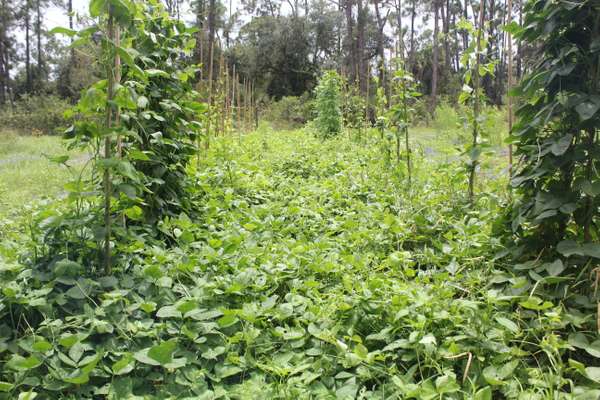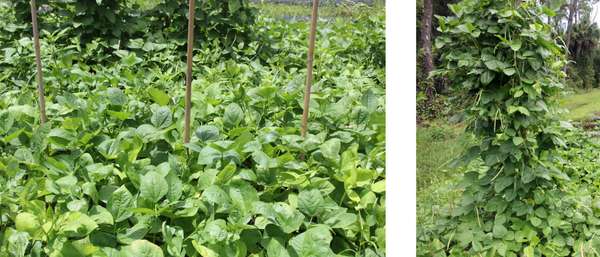Cowpea (Vigna unguiculata) is a legume with edible beans, grown throughout the tropics as a green manure/cover crop. Cowpea thrives in hot climates with annual rainfall of 750 to1100 mm. Once its roots are established, it is quite drought tolerant. High rainfall, however, adversely affects cowpea due to waterlogging and increased disease incidence. At ECHO’s demonstration farm in Florida, which receives nearly 1400 mm annual rainfall, cowpea often grows poorly during the rainy season (June through September). For a high-rainfall area, you could consider more moisture-loving legumes such as velvet bean (Mucuna pruriens) or rice bean (Vigna umbellata), but seeds of these may not be as widely available as cowpea. Here we summarize what we learned after trialing a few cowpea varieties for their potential as cover crops during our rainy season.
Methods

Figure 9. Cowpea vines at the end of a 12-week trial in southwest Florida. Source: Tim Motis
On 13 June 2019, we planted seeds of ten cowpea varieties into two 1-m wide raised beds 0.6 m apart, with one variety grown on each of five 2.3-m long plots per bed (Figure 9). A plot consisted of thirty plants, established in a double row (15 plants per row) and spaced 15 cm (in row) x 30 cm (between row) apart.
We placed four bamboo stakes (50 cm apart) between the two rows of cowpea in every plot. The stakes simulated stalks of maize, allowing us to evaluate the potential of cowpea vines to climb neighboring maize plants. If growing cowpea and maize at the same time, you want a variety that covers the ground well without climbing and shading the maize plants.
We supplied water and fertilizer as needed through a drip irrigation system. We assessed overall plant health/vigor several times during the trial (between 7 and 12 weeks after seeding). As the pods of each variety reached maturity, we estimated the percentage of vine growth in a plot that covered the bamboo stakes. At the end of the trial, 12 weeks after seeding, we collected and weighed vine biomass on the ground (not on poles) within a 1 m2 sampling area in each plot. We were mainly interested in vine growth, so we did not harvest the seed pods.
Findings
Conditions were suitable for testing cowpea varieties’ growth potential under hot, wet conditions. Maximum temperature and humidity, averaged over the 12-week trial period, were 35°C and 87%, respectively. The crop received a total of 711 mm rainfall, more than the approximately 600 mm amount that Akande et al. (2012) found optimal for a cowpea growing season in Nigeria.
Table 2 summarizes what we learned about the ten cowpea varieties. Vines of late-maturing varieties suffered less dieback and discoloration than early-maturing varieties. All four of the varieties with best overall health, and three of the four varieties with the most biomass, were late-maturing varieties that reached the 50% flowering stage (at which flowers appeared on 15 of the 30 plants) 78 days or more after seeding. Of the four varieties with the most biomass, Red Ripper flowered the soonest, reaching the 50% flowering stage at 52 days after seeding.
| Table 2. Top-performing cowpea varieties, with respect to overall health and biomass production, and varieties with the most and least amount of vines climbing bamboo poles. | |||||
|---|---|---|---|---|---|
| Top four varieties in terms of: | Four varieties that climbed: | ||||
| Variety | Origin and/or Supplier | Health | Biomass | Most | Least |
| Iron and Clay | Urban Farmer | √ | √ | √ | |
| 83060 | Nigeria/ECHO | √ | √ | ||
| Carolina Crowder | Southern Exposure Seed Exchange | √ | |||
| Mavuno | Tanzania/ECHO | √ | √ | √ | |
| Mungo Bean | India | ||||
| Red Ripper | Green Cover Seed | √ | √ | ||
| Reddish Brown | Central Africa/ECHO | ||||
| Senegal | Senegal | √ | |||
| Sonoran Yori Muni | Mexico/Native Seeds | √ | |||
| Texas | Urban Farmer | √ | √ | √ | |

Figure 10. Mavuno (left) and Red Ripper (right) cowpea varieties. Source: Tim Motis
We also saw differences in the tendency for varieties to climb (Figure 10). The percentage of vine growth on the poles was over 65 for the four varieties that climbed the most, and less than 40 for the four that climbed the least. Of the four varieties with the most biomass on the ground (2.8 to3.7 t/ha dry weight), only Mavuno showed low potential to climb. Mavuno, in fact, had zero vine growth on the bamboo poles (Figure 10).
Concluding thoughts:
- Late-maturing varieties appear to be best for high rainfall. If you are in a drought-prone area, you would probably want the opposite, an early-maturing variety that can grow and produce during short rainy seasons.
- Mavuno showed promise as a variety that covers the ground well (2.8 t/ha dry biomass) without climbing neighboring plants. More experimentation could confirm this.
- Currently, ECHO’s seed bank in Florida carries Mavuno, Reddish Brown, and 83060. See our website (ECHOcommunity.org) for information on obtaining trial packets of seed. Seeds of most of the other varieties in the trial are available through commercial suppliers (see Table 2). You may have other varieties in your region that you could try as well.
Reference
Akande, S.R., S.A. Olakojo, S.A. Ajayi, O.F. Owolade, J.A. Adetumbi, O.N. Adeniyan, and B.A. Ogunbodede. 2012. Planting date affects cowpea seed yield and quality at Southern Guinea Savanna, Nigeria. Seed Technology 34:51-60.
Cite as:
Motis, T. 2020. Cowpea Varieties for Warm Rainy Season. ECHO Development Notes no. 148